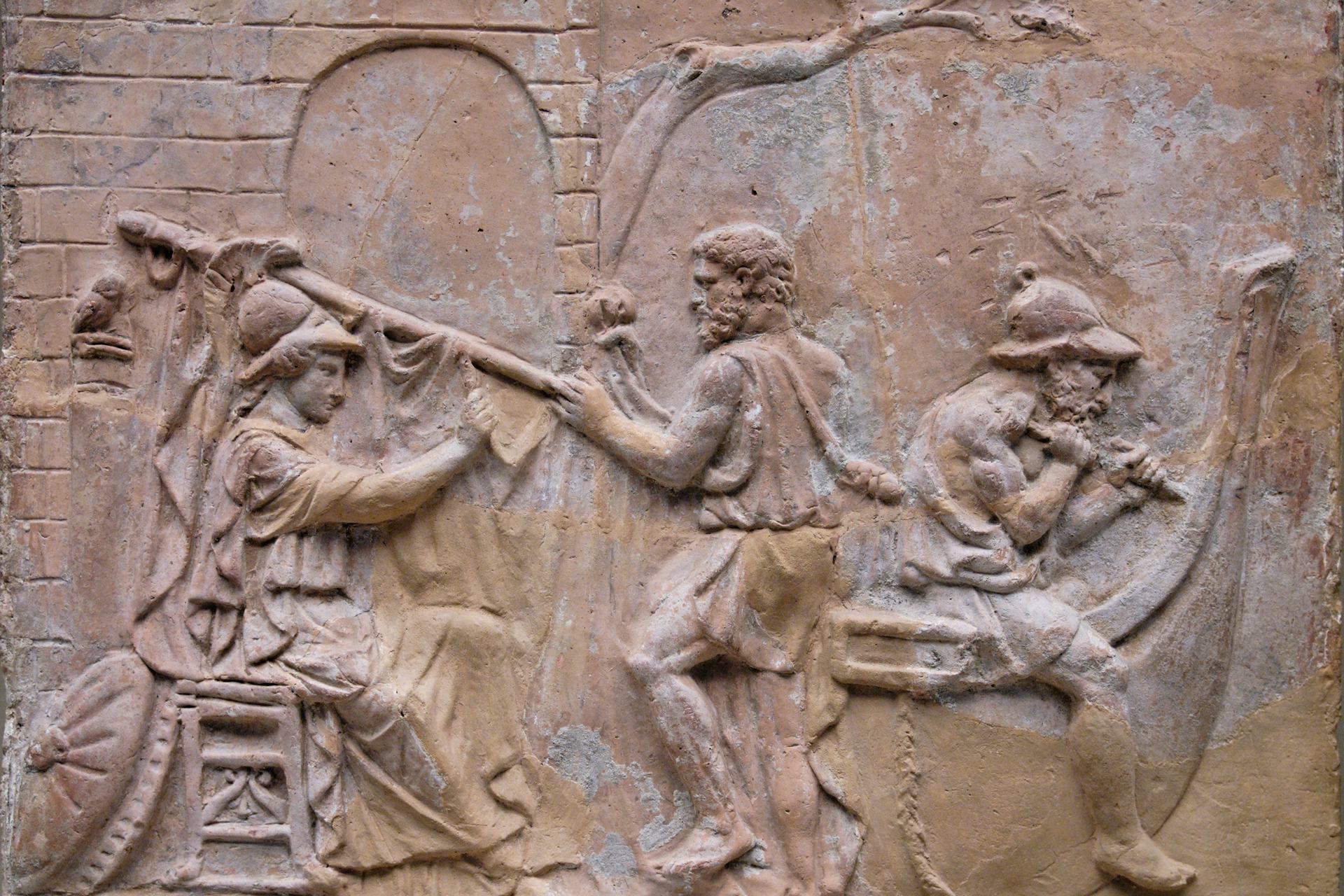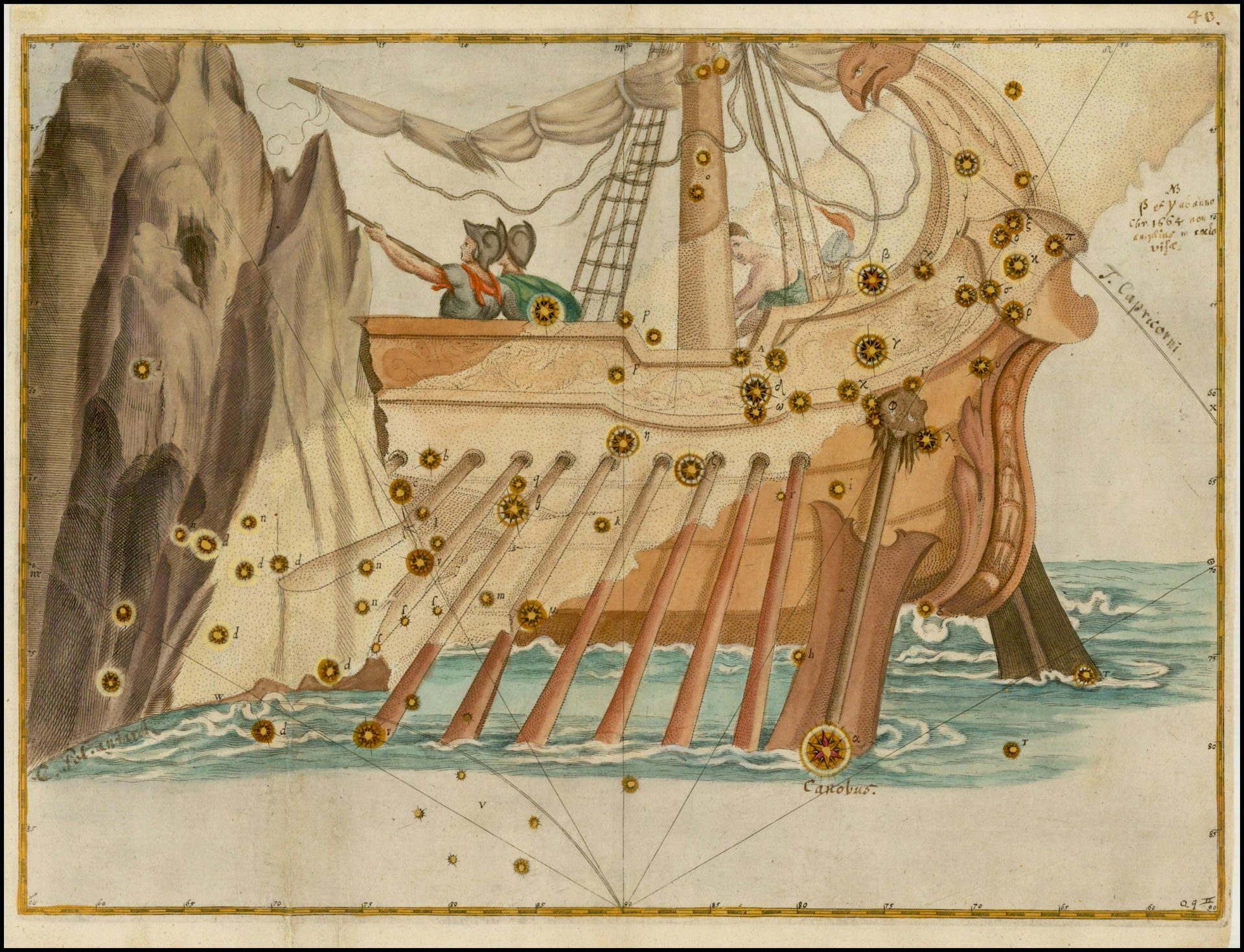Argus (son of Arestor)

Roman terracotta relief showing Argus (right) working on the Argo while Tiphys (center) adjusts the mast with the aid of Athena (left) (probably first century CE)
JastrowCC BY 2.5Overview
Argus was the name of a craftsman, usually called the son of Arestor; he was renowned as a master carpenter, builder, and woodcarver. When Jason put together a band of heroes to sail with him to Colchis to steal the Golden Fleece, it was Argus who was tasked with building a ship worthy of its famous crew.
With the help of Athena, Argus created the Argo (named, according to most sources, for its builder). He then voyaged to Colchis with the other heroes, who were dubbed “Argonauts” in honor of the ship.
Etymology
The name “Argus” (Greek Ἄργος, translit. Árgos) seems to be derived from the word ἀργός (argós), which means “shining, brilliant” as well as “quick, agile.” This word in turn comes from the Indo-European *h₂rǵ-, meaning “white.”[1] There were several mythological figures with this name, many of them (unsurprisingly) associated with the city of Argos in the Peloponnese.
Pronunciation
English
Greek
Argus Ἄργος (Árgos) Phonetic
IPA
[AHR-guhs] /ˈɑr gəs/
Attributes
General
Argus was an important mortal craftsman of Greek mythology. His origins, however, are obscure. Most sources say nothing about his homeland, though the Roman poet Valerius Flaccus reported that he was from Thespiae, a city in the central Greek region of Boeotia.[2]
Argus was most famous for building the Argo, the ship in which Jason and the Argonauts sailed to Colchis on their quest for the Golden Fleece. But he was also regarded as a skilled woodcarver, creating a wooden image of the goddess Rhea that the Argonauts consecrated at Cyzicus during their voyage.[3]
According to one tradition, Argus also fashioned the oldest image of Hera, which was dedicated at Tiryns by the Argive ruler Piras.[4]
Aside from his ability as a craftsman, Argus did not have many distinctive attributes. According to Apollonius of Rhodes, he wore a bull’s hide—perhaps imitating the other Argonauts’ attire, such as Heracles with his lion skin, Ancaeus with his bearskin, or Jason with his leopard skin.[5]
Iconography
Argus sometimes appeared in ancient art, especially on Italian terracotta reliefs and engraved gemstones. He was typically represented with tools in hand, working on the Argo. Sometimes Athena was shown in the background, instructing or helping him.[6]
Family
According to the best-known tradition, Argus was the son of a man named Arestor (or Alector).[7] But other traditions made him the son of Polybus and Argea, or of Danaus.[8] The Argus who built the Argo was sometimes identified with the Argus who was the son of Phrixus and Chalciope, though in the usual account these seem to have been two distinct individuals.[9]
Mythology
When Peleus sent his nephew Jason on a perilous quest to steal the Golden Fleece—held in Colchis by the cruel king Aeetes—Jason gathered a crew of mighty heroes to sail across the Aegean and Black Seas. The builder Argus was commissioned to craft them a ship worthy of this journey.
The vessel that Argus constructed for Jason and his crew was probably the most famous ship of Greek mythology. It would be called the Argo, either after its builder (as in the standard tradition)[10] or because of its speed (ἀργός/argós means “speedy” in Greek).[11]
The Argo was a large warship, usually likened to a type of vessel called a penteconter, which had space for fifty oarsmen.[12] Some said that the Argo was the first ever ship to be built, thus making Argus the inventor of shipbuilding.[13]
In the standard account, Argus seems to have built the Argo in Thessaly, close to the kingdom of Jason’s uncle Pelias, using timber from the woods of Mount Pelion.[14] But others said that Argus built the ship further south, in Argos,[15] Corinth,[16] or Thespiae.[17]
In building the Argo, Argus was aided and instructed by Athena herself, the goddess of wisdom and craftsmanship.[18] Athena brought a piece of sacred oak from the shrine of Zeus in Dodona, which she set in the bow of the ship; this gave the Argo the ability to speak.[19]
The Argo—sometimes described as πασιμέλουσα (pasimélousa), “known by all”—was dedicated to Poseidon or Hera after Jason and the Argonauts returned to Greece.[20] Others said it was transformed into a constellation.[21]

Illustration of the constellation Argo
Johann Bayer, Uranometria (1603)Public DomainOnce the ship was complete, Argus joined the other crew members on their voyage to Colchis, wishing to be on hand to make repairs along the way.[22]
Popular Culture
As the builder of the Argo, Argus is essential to any retelling of the myth of Jason and the Argonauts. He continues to feature (albeit as a minor character) in modern adaptations of the myth, including Robert Graves’ novel Hercules, My Shipmate (1944) and the film Jason and the Argonauts (1963).